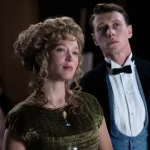Truth, by Scott Nye
The existing DVD long out of print, Los Angeles residents have cause to celebrate this Friday the chance to see Godard in his prime when his second feature, Le Petit Soldat, comes to West Los Angeles’ Nuart Theater in a new 35mm print (it will play St. Louis and San Diego in the months to come. Beyond its scarcity, beyond it being his first collaboration with future-wife/muse Anna Karina, and beyond it being an exceptional film, it pairs perfectly with his more-famous first feature, Breathless, to point the way toward his career to come. And did I mention it’s an exceptional film?
Where Breathless was all jazz, hanging out, guns, cars, and women, Le Petit Soldat subverts that, sticking us with protagonist Bruno Forestier (Michel Subor), who’s a photographer by trade and a French intelligence operator on the side. Ordered to kill a radio host sympathetic to the Algerian cause, mostly to prove his loyalty, Bruno’s method of finding ways to not kill somebody range from comically inconvenient to active resistance, culminating to a confrontation in which he has a gun to his own back as he attempts to aim his. He states early on that he won’t kill unless forced to, but perhaps even that won’t be enough.
In the meantime, he’s still a young man in his 20s, and a bet with a friend that he won’t fall in love with Veronica Dreyer (Karina) within five minutes of meeting her is quickly lost. The romance plot is not merely an angle or subplot or tossed in there for commercial considerations, the way so many romances are, but integral to Godard’s aims with this picture, or nearly any other of the period. Romance humanizes, so even though Godard himself would take issue with Bruno’s stated cause, the fact that he gives him so much time to spend with Karina speaks to, really, the fundamental opposition to any war effort – that is disrupts us from the things that really matter, while ultimately accomplishing little. Though I wouldn’t be surprised if the filmmaker’s working methods (a little script, a lot of improvisation) made a little bit more room for this story as Godard himself was falling in love with her.
More importantly, the romance doesn’t devalue the urgency of the conflict, and the film’s most famous scene brings this into stark relief. Bruno, discovered by Algerian independence fighters, is tortured, and not in a way that can be largely brushed off. Remember, this is 1960, and while methods to make violence on film both more “real” and more safe would be developed at the end of the decade and gradually perfected over the next several, this was still an age in which, to shoot somebody onscreen, all you had was the sound of a gunshot and a guy clutching his chest. While Godard got far on illusion, continuous shots of lit matches being held to Bruno’s (and thus, Subor’s) hands, or a soaked rag around his face, make it clear that the actor endured, if only briefly, the very violence we see onscreen. Richard Brody wrote about how, years later, Subor confessed to actually being hooked up to electrical wires as current was run through them, and notes that a journalist at the time observed “marks on his wrists and ankles.” Godard’s famous statement that “cinema is truth twenty-four times per second” comes from this film, and while the value of that statement extends far beyond the frames of this film, so too is it vital to accounting for what’s before us.
To what end? Well, exposing the still-sadly-prevalent practice of torture is a perfectly noble one all its own (in 1960, Godard had to explain waterboarding; now, that seems superfluous), and by downplaying the political machinations – both of governments and of small cells – in favor of the experience of one man caught in the middle, the human cost is not merely a theoretical concern. Scenes of debriefings and orders given fly by, but Godard spends several minutes with Bruno and Veronica as they fall in love, and just as many in the hotel room in which Bruno is tortured. “All you need for a movie is a girl and a gun,” Godard famously said. Breathless, Godard’s first feature, found all the fun inherent in that sentiment; Le Petit Soldat shows the real ramifications of each. That doesn’t make the latter a more moral (let alone better) act, but illustrates how one film can strengthen another, especially when it comes to Godard in the 1960s, whose work grows more vital when viewed as a whole; Pierrot le fou is not what it is without Contempt or Breathless, nor Band of Outsiders without Masculin féminin or Vivre sa vie without 2 or 3 Things I Know About Her. Or any of those together, or all of those altogether. Cinema is truth 24 frames per second, but each frame only tells part of that truth. It works with the others to tell the rest.


























